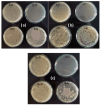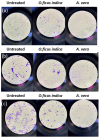The Potential of Aloe vera and Opuntia ficus-indica Extracts as Biobased Agents for the Conservation of Cultural Heritage Metals
- PMID: 40559410
- PMCID: PMC12195019
- DOI: 10.3390/metabo15060386
The Potential of Aloe vera and Opuntia ficus-indica Extracts as Biobased Agents for the Conservation of Cultural Heritage Metals
Abstract
Background/objectives: Biocorrosion, driven by microbial colonization and biofilm formation, poses a significant threat to the integrity of metal artifacts, particularly those composed of copper and its alloys. Pseudomonas aeruginosa, a bacterial species that reduces nitrates, plays a key role in this process. This study explores the potential of two metabolite-rich plant extracts, Aloe vera and Opuntia ficus-indica, as sustainable biobased inhibitors of microbial-induced corrosion (MICOR).
Methods: The antibacterial and antibiofilm activities of the extracts were evaluated using minimal inhibitory concentration (MIC) assays, time-kill kinetics, and biofilm prevention and removal tests on copper, bronze, and brass samples. Spectrophotometric and microbiological methods were used to quantify bacterial growth and biofilm density.
Results: Both extracts exhibited significant antibacterial activity, with MIC values of 8.3% (v/v). A. vera demonstrated superior bactericidal effects, achieving reductions of ≥3 log10 in bacterial counts at lower concentrations. In antibiofilm assays, both extracts effectively prevented biofilm formation and reduced established biofilms, with A. vera exhibiting greater efficacy against them. The active metabolites-anthraquinones, phenolics, flavonoids, and tannins-likely contribute to these effects.
Conclusions: These findings highlight the dual role of A. vera and O. ficus-indica extracts as both corrosion and biocorrosion inhibitors. The secondary metabolite profiles of these plants support their application as eco-friendly alternatives in the conservation of metal cultural heritage objects.
Keywords: Aloe vera (L.) Burm.f.; Opuntia ficus-indica (L.) mill.; Pseudomonas aeruginosa; antibacterial activity; biocorrosion; biofilm inhibition; copper alloys; cultural heritage conservation; natural corrosion inhibitors; plant secondary metabolites.
Conflict of interest statement
The authors declare no conflicts of interest.
Figures






Similar articles
-
Comparative evaluation of antimicrobial, antibiofilm, antioxidant, antiviral, and antidiabetic activities of copper oxide nanoparticles biofabricated via Opuntia ficus indica.Sci Rep. 2025 Jul 10;15(1):24823. doi: 10.1038/s41598-025-08878-3. Sci Rep. 2025. PMID: 40640332 Free PMC article.
-
Liposome-encapsulated antibiotics and biosurfactants: an effective strategy to boost biofilm eradication in cooling towers.Microb Cell Fact. 2025 Jun 18;24(1):135. doi: 10.1186/s12934-025-02746-5. Microb Cell Fact. 2025. PMID: 40533735 Free PMC article.
-
Anti-steatotic effect of Opuntia ficus-indica extracts rich in betalains and phenolics from fruit peel and pulp of different varieties in in vitro models.J Physiol Biochem. 2025 Jun 20. doi: 10.1007/s13105-025-01097-4. Online ahead of print. J Physiol Biochem. 2025. PMID: 40540118
-
Home treatment for mental health problems: a systematic review.Health Technol Assess. 2001;5(15):1-139. doi: 10.3310/hta5150. Health Technol Assess. 2001. PMID: 11532236
-
Standard versus biofilm antimicrobial susceptibility testing to guide antibiotic therapy in cystic fibrosis.Cochrane Database Syst Rev. 2017 Oct 5;10(10):CD009528. doi: 10.1002/14651858.CD009528.pub4. Cochrane Database Syst Rev. 2017. Update in: Cochrane Database Syst Rev. 2020 Jun 10;6:CD009528. doi: 10.1002/14651858.CD009528.pub5. PMID: 28981972 Free PMC article. Updated.
References
-
- Del Junco A.S., Moreno D.A., Ranninger C., Ortega-Calvo J.J., Sáiz-Jiménez C. Microbial induced corrosion of metallic antiquities and works of art: A critical review. Inter. Biodeter. Biodegr. 1992;29:367–375. doi: 10.1016/0964-8305(92)90053-Q. - DOI
-
- Yuk S., Azam A.H., Miyanaga K., Tanji Y. The contribution of nitrate-reducing bacterium Marinobacter YB03 to biological souring and microbiologically influenced corrosion of carbon steel. Biochem. Eng. J. 2020;156:107520. doi: 10.1016/j.bej.2020.107520. - DOI
LinkOut - more resources
Full Text Sources

